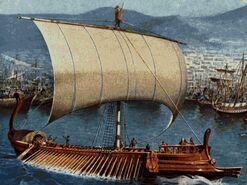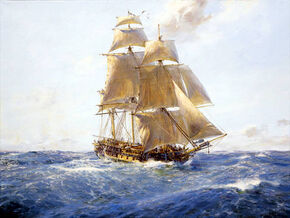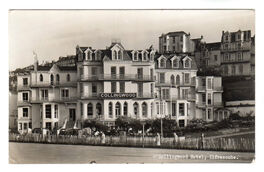| <font!style="background:#1a1a1a; width:1px;" rowspan="5"| color=white>USS Odyssey | |||||||||||||
|---|---|---|---|---|---|---|---|---|---|---|---|---|---|

|
Rosters | Specifications | Information | Communications | |||||||||
| Senior Staff | Ship Statistics | Ships to Bear the Name | IC Group | ||||||||||
| Full Crew List | Deck Layout | Alert Conditions | Common Code Words | Mission Logs | ||||||||||
| Starbase 520 | Support Craft | Ebrand Phone | |||||||||||
| NCC-73012 | |||||||||||||
Throughout history, a long line of ocean-going vessels, spacecraft and starships have born the name Odyssey.
All of the vessels listed below can be found in the form of models in a cabinet in the Odyssey's observation lounge, whilst paintings and detailed historical information are presented in a historical display on the primary recreation deck. Historical simulations of each ship have been programmed into the holodeck, including guided tours and simulated battle scenarios.
Odysseus's Ship[]

Fifty-oared penteconter[]
Active: possibly 12th Century B.C.
Fate: Mythical, swallowed by Charybdis
Throughout Homer’s ‘Odyssey’, the mythical hero Odysseus makes use of an unnamed ship which is only described as swift and black-hulled. His original ship is wrecked when it is caught between Scylla and Charybdis, but he receives another ship as a gift from the master shipwrights of Phaeacia, whose ships are described as follows:
“…their vessels have no rudders as those of other nations have, but the ships themselves understand what it is that we are thinking about and want; they know all the cities and countries in the whole world, and can traverse the sea just as well even when it is covered with mist and cloud, so that there is no danger of being wrecked or coming to any harm…”
French ship Odyssée[]

Unité-class 24-gun frigate[]
Commissioned: April 1794
Construction Base: Le Havre
Decommissioned: 1807
Fate: Sold out of service, became a hydrographic survey vessel.

Jean-Baptiste Picarde
In Earth's Age of Sail, the Odyssée was a French light frigate that served with distinction throughout the Napoleonic Wars, terrorising British shipping in the South Pacific and capturing many heavily-laden East Indiamen. Her commander, Capitaine de vaisseau Jean-Baptiste Picarde, established himself a reputation as a excellent sailor and a "fighting captain" who never shied away from a fight or a fair prize.
After the fall of Napoleon, Odyssée served the French government as an oceanographic survey vessel, charting islands and mapping the ocean floor. The prize money from her captain's bucanneering allowed him to establish a vineyard, which began producing Château Picard wine in 1798.
[]
32-bedroom seafront hotel[]

During Earth’s Second World War, ‘HMS Odyssey’ was a non-existent ship that 'sailed on paper' to try and fool enemy intelligence. Officers assigned to the fictional HMS Odyssey were actually working at the Collingwood Hotel in Ilfracombe, North Devon, England, which had been turned into a cipher office for decrypting German communications. After the war, the Collingwood continued functioning as a perfectly ordinary hotel until it was unceremoniously demolished in 2012.
RV Odyssey Explorer[]

Marine archaeology vessel[]
Launched: 1972
Fate: Impounded by the Spanish government, 2007
Originally built as a trawler, the Odyssey Explorer was bought by a private company named Odyssey Marine Exploration and converted into a floating laboratory for deep-sea treasure hunting, locating shipwrecks and sunken treasure on the surface of Earth’s oceans.
In 2007, the Odyssey Explorer recovered $500 million worth of silver and gold coins from the wreck of a Spanish frigate named the Nuestra Señora de las Mercedes, which sank in 1804. Odyssey Explorer was then seized by the Spanish authorities, and the owners were forced to relinquish their claim to the treasure.
Odyssey III[]

Commercial spaceplane[]
Launched: 2037
In the years shortly before Earth’s Third World War, the Odyssey III was a commercial spaceplane powered by an aerospike rocket engine. It was part of the space tourism industry, transporting wealthy passengers to orbital space hotels and providing high-speed suborbital spaceflights between destinations on the planet’s surface.
SS Odyssey[]
Conestoga-class colony ship[]

Launched: 2069
Construction Base: Bozeman, Montana
Fate: Dismantled to provide construction materials for Deneva colony
The SS Odyssey was one of several colony ships designed and built in the years immediately after Zefram Cochrane's first successful warp flight, realising the potential of warp speed by creating a "wagon train to the stars" and resettling humans on new worlds unspoiled by nuclear devestation.
These ships were designed to make a single journey at just above Warp 1, carrying 200 colonists to a planet which they would then settle, dismantling the ship and converting its compartmental hull into the first buildings of a fledgling colony. SS Odyssey established the original township that grew into the Deneva colony, now one of the major centres of trade and cultural exchange in the Alpha Quadrant.
USS Odyssey NCC-1198[]

Horizon-class explorer[]
Commissioned: 2206
Construction Base: Copernicus Shipyards, Luna
Status: exhibited in the Starfleet Museum Orbital Complex
The first Federation starship to bear the name. The original USS Odyssey and its Horizon-class sister ships were the first Starfleet vessels to be built for long-range scientific missions, designed as pure explorers rather than hybrid warships. In the height of tensions with the Klingon Empire, pugnacious admirals dismissed the idea as an idealistic extravagance, but the fleet’s senior scientists managed to rally public support and get the class approved by the Federation Council.

Odyssey's sister ship, the USS Beagle, in 2220
The unprecedented range of these vessels enabled Starfleet to launch its first 5-year missions of exploration: Odyssey departed Starbase 12 in March 2209 and began 62 months of independent operations, exploring sectors outward of the Rigel system. Odyssey set numerous records for sustained speed, distance, and endurance, and made first contact with 12 spacefaring races, including the Edosians.
She went on to carry out four more 5-year missions, and was finally decommissioned in 2252, after which she became a private survey vessel with a civilian crew, chartered by the Federation Science Council. She didn’t retire from this role until 2297, when her 90-year-old hull was finally deemed unspaceworthy. After some restoration work, Odyssey was put on display at the orbital complex of the Starfleet Museum, where she is still one of the most popular exhibits, lovingly maintained by museum staff.
USS Odyssey NCC-2009[]
Excelsior-class cruiser[]

Ordered: 2288
Commissioned: 2292
Construction Base: Beta Antares Fleet Yards
Received Refit: 2300
Fate: disappeared in 2352
USS Odyssey NCC-2009 was part of the first production run of Excelsior-class starships, commissioned after the failure of the transwarp development initiative and the conversion of the prototypes USS Excelsior and USS Proxima into regular warp ships. In recognition of the scientific legacy of her predecessor, the Excelsior-class Odyssey was chosen to be the testbed for an advanced sensor pallet, mounted above the primary impulse engines. This equipment was originally designed for scientific missions of exploration, but Starfleet Command often assigned Odyssey to the Klingon border, using her advanced sensor capabilities to hunt for cloaked Klingon vessels.
Odyssey was refitted after the Khitomer Accords, and she began to play a bigger role in scientific missions. She stayed in service for half a century, establishing a reputation for being the best ship to send whenever ‘weird’ spatial phenomena needed investigating. Odyssey also conducted several notable diplomatic missions: Excelsior-class ships were often used as the 'limousines' of the fleet during this period, due to their luxurious staterooms and high standard of military discipline. They were often sent to receive important alien dignitaries and show them all of the cultural and culinary benefits of joining the Federation.
Captain Ra-Zarethandeii, an Efrosian, took command in 2305 and remained captain of the Odyssey for forty-seven years. He was a popular captain who instigated the tradition of inviting the senior staff to drink a bottle (or three) of Château Picard together every year on Earth's Bastille Day, in commemoration of the ship's proud naval ancestry.
After a long and distinguished career, Odyssey disappeared with all hands whilst conducting long-range scans of a subspace anomaly in Breen space. Investigations failed to discover the cause of the ship’s mysterious disappearance, and Starfleet eventually abandoned the search, listing Odyssey as ‘presumed destroyed’.
USS Odyssey NCC-71832[]
Galaxy-class explorer[]

Commissioned: 2362
Construction Base: Utopia Planitia Fleet Yards
Fate: destroyed in 2370
The USS Odyssey was the fourth Galaxy-class explorer to be commissioned for active service, after the USS Galaxy, the USS Enterprise NCC-1701-D, and the USS Yamato. She was also the second ship of her class to be destroyed in the line of duty. In 2370, under the command of Captain Keogh, Odyssey went through the Bajoran wormhole to rescue Captain Benjamin Sisko from Dominion captivity. Odyssey was rammed by a Jem’Hadar vessel and destroyed with all hands, apart from civilians and non-essential personnel who had been left behind on Deep Space Nine. This incident served as the cornerstone of the Dominion War, and prompted a fleet-wide rearmament programme.
USS Odyssey NCC-73012[]
Galaxy-class explorer/battleship[]

Commissioned: 2371
Construction Base: Utopia Planitia Fleet Yards
Refitted: 2380
Status: Still in active service
When the former USS Odyssey was destroyed by the Jem’Hadar, Starfleet began to prepare for the likelihood of war with the Dominion. The fleet was suffering from a shortage of large capital ships, after the destruction of the Enterprise-D at Veridian III and the USS Yamato by an ancient Iconian computer virus in 2365. With the new Sovereign-class prototypes still years away from completion, Starfleet Command decided to produce three new Galaxy-class starships with updated shields and tactical systems, rushing them through the yards at Utopia Planitia. The naming committee chose to honour the sacrifice made by the crew of the former USS Odyssey by reusing the name, hoping to show the Dominion that for every ship they destroyed, another would take its place.
The new Odyssey served as part of Galaxy Wing 9-1, participating in Operation Return and the Battle of Chin’toka, where she famously kept fighting even after her bridge was destroyed, going toe-to-toe with a large Dominion battleship. After the war, she was refitted as an explorer, and has enjoyed a more peaceful career in the decades since. She is currently commanded by Captain Brek and attached to Outpost Eden.
[]
Curated by Mr. Xon.

